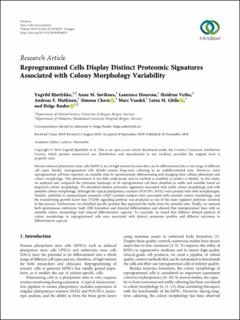| dc.contributor.author | Bjørlykke, Yngvild | en_US |
| dc.contributor.author | Søviknes, Anne Mette | en_US |
| dc.contributor.author | Hoareau, Laurence | en_US |
| dc.contributor.author | Vethe, Heidrun | en_US |
| dc.contributor.author | Mathisen, Andreas | en_US |
| dc.contributor.author | Chera, Simona | en_US |
| dc.contributor.author | Vaudel, Marc | en_US |
| dc.contributor.author | Ghila, Luiza | en_US |
| dc.contributor.author | Ræder, Helge | en_US |
| dc.date.accessioned | 2020-06-08T11:32:18Z | |
| dc.date.available | 2020-06-08T11:32:18Z | |
| dc.date.issued | 2019-11-18 | |
| dc.Published | Bjørlykke Y, Søviknes AM, Hoareau ML, Vethe H, Mathisen A, Chera S, Vaudel M, Ghila L, Ræder H. Reprogrammed Cells Display Distinct Proteomic SignaturesAssociated with Colony Morphology Variability. Stem Cells International. 2019:8036035 | eng |
| dc.identifier.issn | 1687-966X | |
| dc.identifier.issn | 1687-9678 | |
| dc.identifier.uri | https://hdl.handle.net/1956/22488 | |
| dc.description.abstract | Human induced pluripotent stem cells (hiPSCs) are of high interest because they can be differentiated into a vast range of different cell types. Ideally, reprogrammed cells should sustain long-term culturing in an undifferentiated state. However, some reprogrammed cell lines represent an unstable state by spontaneously differentiating and changing their cellular phenotype and colony morphology. This phenomenon is not fully understood, and no method is available to predict it reliably. In this study, we analyzed and compared the proteome landscape of 20 reprogrammed cell lines classified as stable and unstable based on long-term colony morphology. We identified distinct proteomic signatures associated with stable colony morphology and with unstable colony morphology, although the typical pluripotency markers (POU5F1, SOX2) were present with both morphologies. Notably, epithelial to mesenchymal transition (EMT) protein markers were associated with unstable colony morphology, and the transforming growth factor beta (TGFB) signalling pathway was predicted as one of the main regulator pathways involved in this process. Furthermore, we identified specific proteins that separated the stable from the unstable state. Finally, we assessed both spontaneous embryonic body (EB) formation and directed differentiation and showed that reprogrammed lines with an unstable colony morphology had reduced differentiation capacity. To conclude, we found that different defined patterns of colony morphology in reprogrammed cells were associated with distinct proteomic profiles and different outcomes in differentiation capacity. | en_US |
| dc.language.iso | eng | eng |
| dc.publisher | Hindawi | eng |
| dc.rights | Attribution CC BY | eng |
| dc.rights.uri | http://creativecommons.org/licenses/by/4.0/ | eng |
| dc.title | Reprogrammed Cells Display Distinct Proteomic SignaturesAssociated with Colony Morphology Variability | en_US |
| dc.type | Peer reviewed | |
| dc.type | Journal article | |
| dc.date.updated | 2020-01-30T12:53:50Z | |
| dc.description.version | publishedVersion | en_US |
| dc.rights.holder | Copyright 2019 Yngvild Bjørlykke et al. | |
| dc.identifier.doi | https://doi.org/10.1155/2019/8036035 | |
| dc.identifier.cristin | 1756519 | |
| dc.source.journal | Stem Cells International | |
| dc.relation.project | Norges forskningsråd: 247577 | |

